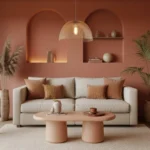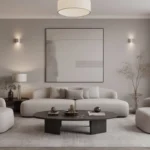You know that feeling when you walk into a living room and just want to sink into the couch and never leave? Yeah, that’s what we’re after here. Your living room should be more than just a place to dump your stuff—it should be your personal sanctuary, the spot where you unwind after a brutal day, binge-watch your favorite shows, and host those impromptu hangouts that somehow turn into all-nighters.
I’ve spent way too much time scrolling through Pinterest at 2 AM (no judgment, right?), obsessing over living room designs that make me want to redecorate my entire space. So I’m sharing 15 living room inspiration ideas that’ll transform your space from “meh” to “wow, can I just live here forever?” Let’s get into it.
Modern Minimalist Living Room

Less is more—whoever said that clearly knew what they were talking about. A modern minimalist living room strips away all the unnecessary clutter and leaves you with clean lines, functional furniture, and a sense of calm that’s honestly hard to beat.
Picture this: a sleek low-profile sofa in neutral tones, maybe a light grey or crisp white. You’ve got a simple coffee table—glass or light wood works perfectly—and absolutely zero knick-knacks collecting dust. The beauty here is in the intentional empty space. You’re not trying to fill every corner; you’re creating breathing room.
What I love about minimalist design is how it forces you to be selective. Every piece you choose actually matters. That mid-century modern chair? It’s not just furniture; it’s a statement piece. The single large-scale artwork on the wall? It becomes the focal point without competing with a dozen other things.
Keep your color palette simple—think whites, greys, blacks, with maybe one accent color if you’re feeling spicy. And here’s the kicker: minimalist doesn’t mean cold or boring. Add warmth through textures—a chunky knit throw, a plush rug, or some soft linen cushions. Trust me, your space will thank you.
Cozy Boho Chic Space
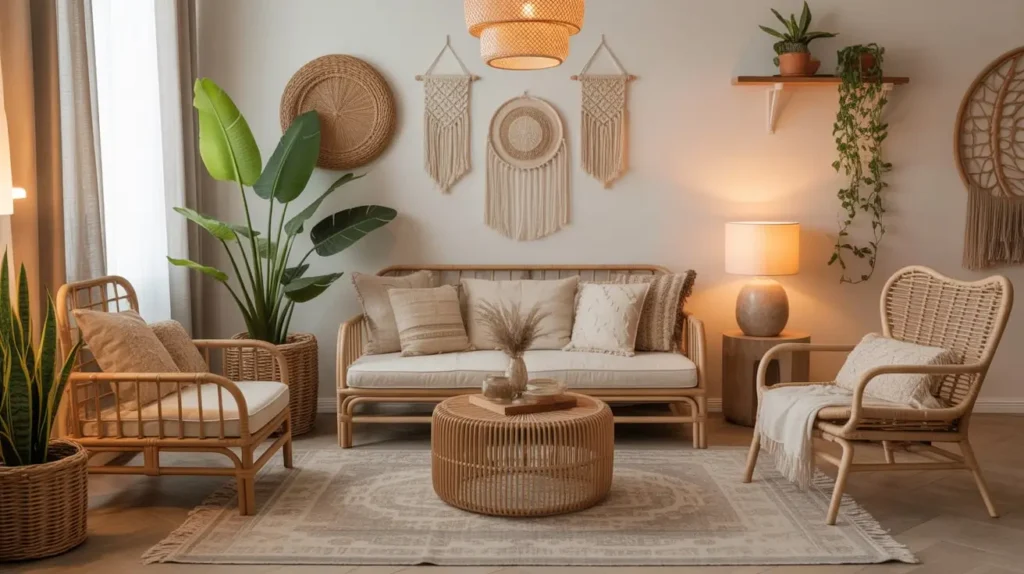
If minimalism feels too sterile for you, let me introduce you to its free-spirited cousin: boho chic. This style is basically the design equivalent of a warm hug mixed with world travel vibes.
Boho living rooms celebrate layers, patterns, and personality. We’re talking macramé wall hangings, rattan furniture, vintage rugs with intricate patterns, and plants—so many plants. Honestly, you can never have too many plants in a boho space. They bring life and that earthy, grounded feeling that makes everything feel cozy.
Mix and match your textiles without fear. Throw pillows in different patterns? Absolutely. A moroccan pouf next to a vintage leather ottoman? Why not! The boho aesthetic thrives on that collected-over-time look, like you’ve gathered treasures from flea markets and travels around the world.
Color-wise, think warm earth tones—terracotta, mustard yellow, burnt orange, mixed with creamy whites and natural wood tones. Add some brass or copper accents through light fixtures or decorative objects. The key is creating a space that feels lived-in, comfortable, and uniquely yours. No cookie-cutter vibes here.
Scandinavian Neutral Haven
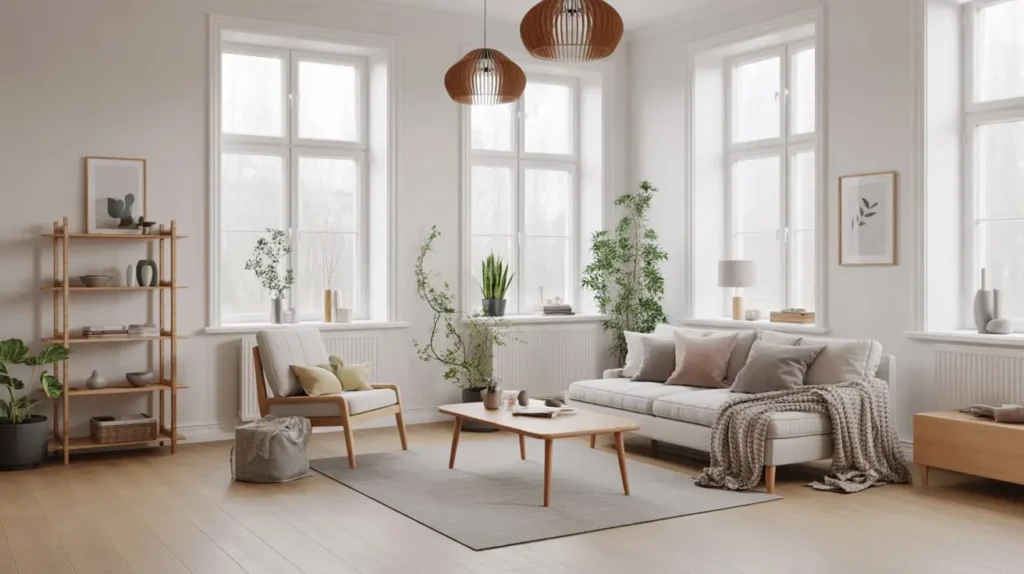
Scandinavian design is what happens when minimalism meets coziness, and honestly? It’s perfection. This style originated in Nordic countries where winters are long and dark, so they figured out how to create bright, warm, inviting spaces that combat the gloom.
Your foundation is a neutral color palette—whites, soft greys, beiges—but you’re adding warmth through natural materials. Think light wood floors, wooden furniture with clean lines, and lots of natural light. Scandinavian rooms often feature large windows with minimal or no window treatments to maximize that precious daylight.
Texture is your best friend here. Layer in sheepskin throws, chunky knit blankets, linen curtains, and wool rugs. These elements add depth without cluttering the space. The furniture tends to be functional and beautiful—no excess, but never boring.
Here’s what makes Scandi style work so well: it’s incredibly livable. You’re not afraid to actually use your living room because everything is practical and comfortable. Add some greenery, maybe a few candles for that hygge vibe (because Scandinavians invented coziness, basically), and you’ve got a space that feels like a peaceful retreat.
Industrial Loft Style Living Room

Want your living room to look like it belongs in a converted warehouse in Brooklyn? Industrial style is calling your name. This aesthetic embraces raw, unfinished elements and turns them into design features.
Exposed brick walls? Check. Visible ductwork and pipes? Absolutely. Concrete floors or high ceilings with metal beams? You’re speaking my language. The industrial look celebrates the bones of a building rather than hiding them.
For furniture, think leather sofas—preferably with some wear and character—metal shelving units, reclaimed wood coffee tables, and vintage factory stools. The materials are key: metal, wood, leather, and concrete dominate the palette.
Your color scheme leans toward neutrals with an edge—greys, blacks, whites, with metal finishes in black iron or brushed steel. But here’s where you keep it from feeling cold: add warmth through lighting (Edison bulbs are basically required, FYI), textured throws, and maybe some vintage rugs.
IMO, industrial style works best when you balance the hard edges with softer elements. Too much concrete and metal, and you’ll feel like you’re living in a parking garage. Mix in some comfort, and you’ve got that perfect urban loft vibe that’s both edgy and livable.
Also Read: 15 Dreamy Apartment Living Room Inspiration Ideas for 2025 Homes
Mid-Century Modern Vibes
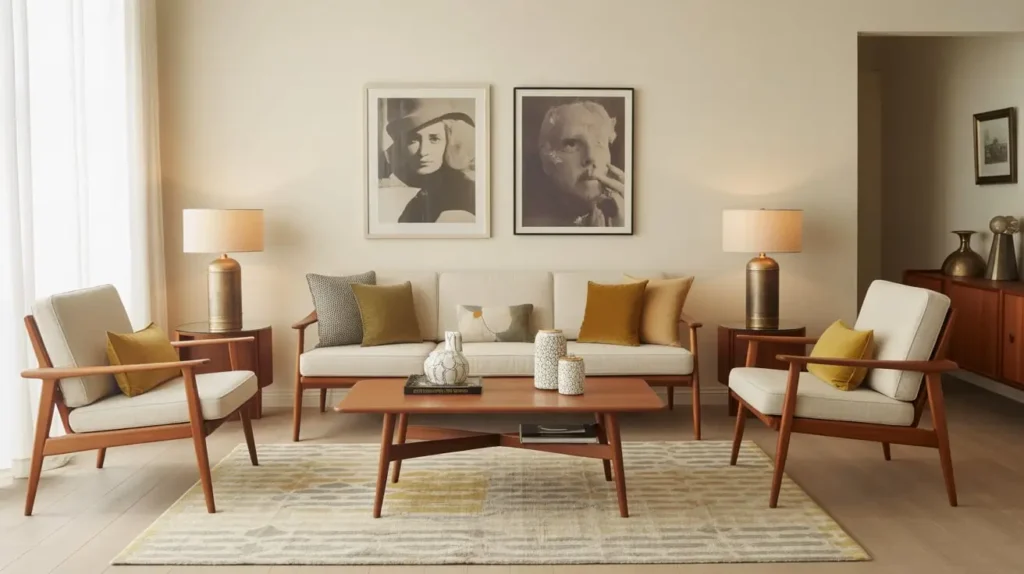
The 1950s and 60s gave us some seriously timeless furniture design, and mid-century modern style keeps those classics alive and thriving. This look is all about clean lines, organic forms, and functional beauty.
Your furniture should feature tapered legs, gentle curves, and quality craftsmanship. Think Eames lounge chairs, teak sideboards, and low-profile sofas in rich jewel tones or classic neutrals. The silhouettes are distinctive—you know mid-century furniture when you see it.
Color plays a bigger role here than in some other styles. You might go bold with a mustard yellow sofa or an orange accent chair. Or keep things neutral with walnut wood tones, greys, and whites, letting the furniture shapes be the stars.
What I appreciate about mid-century modern is how it’s stood the test of time. These pieces don’t look dated (well, except intentionally retro); they look classic. Add some vintage-inspired lighting—a Sputnik chandelier or arc floor lamp—and geometric patterns through rugs or artwork.
The key is maintaining that balance between form and function. Everything looks good but also serves a purpose. No fussy decorative elements, just thoughtfully designed pieces that make your space feel curated and cool.
Japandi Calm Living Space

Take the coziness of Scandinavian design and mix it with the zen simplicity of Japanese aesthetics, and you get Japandi—probably the most calming design trend to emerge in recent years.
This style emphasizes quality over quantity, natural materials, and a serious commitment to decluttering. Your living room becomes a peaceful sanctuary where every element earns its place through beauty or function (ideally both).
Furniture sits low to the ground with clean, simple lines. Think platform sofas, low wooden coffee tables, and minimal ornamentation. The color palette is neutral and muted—soft greys, beiges, off-whites—with natural wood tones providing warmth.
What sets Japandi apart is the attention to craftsmanship and natural imperfection. You might choose handmade ceramics, a perfectly imperfect wooden bowl, or textiles with subtle variations. There’s beauty in the handcrafted and the organic.
Keep decorations minimal but meaningful. A single ikebana arrangement, a carefully chosen piece of art, or a beautiful ceramic vase. The space feels intentional and calm, never cluttered or chaotic. Add sliding shoji-style screens or paper lanterns for authentic Japanese touches.
Honestly, if you struggle with clutter or feel overwhelmed by busy spaces, Japandi might be your design soulmate. It forces you to curate carefully and creates a living room that feels like a deep breath after a stressful day.
Farmhouse Rustic Charm
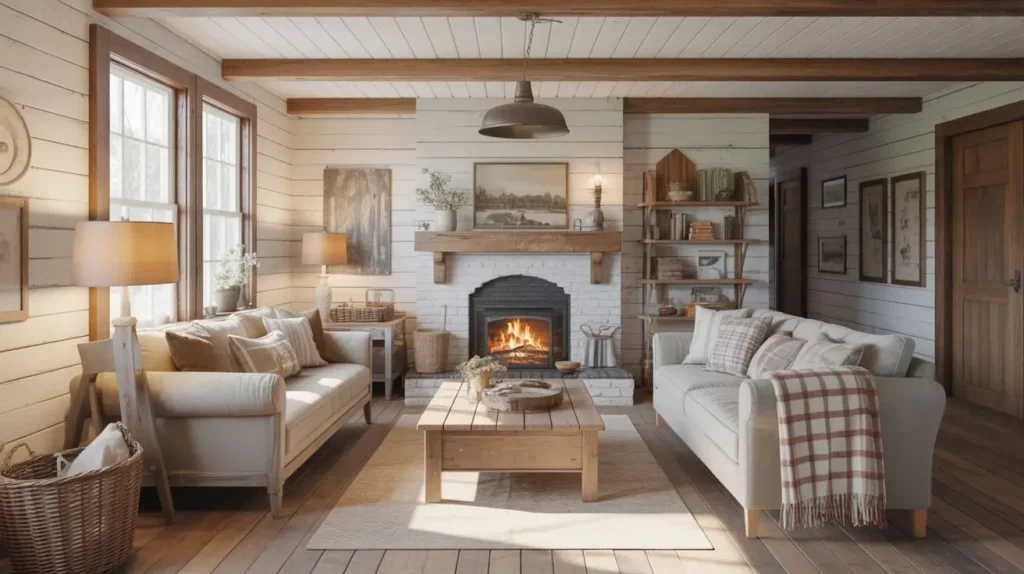
Farmhouse style brings that countryside, lived-in comfort to your living room—and you don’t even need to live on an actual farm (thank goodness, because I can barely keep plants alive :/).
This aesthetic celebrates rustic materials, vintage finds, and cozy comfort. We’re talking shiplap walls (though maybe we’ve reached peak shiplap?), reclaimed wood beams, and furniture that looks like it’s been passed down through generations.
Your color palette centers on whites and creams with natural wood tones. Add texture through burlap, linen, cotton, and chunky knits. A distressed leather sofa or overstuffed slipcovered couch invites you to sink in and stay awhile.
Decorative elements lean vintage and practical: galvanized metal buckets (now holding plants or throws), antique signs, mason jars, and lots of natural elements like cotton stems or wheat bundles. But here’s the trick—don’t go overboard. You want charming, not kitschy craft-store explosion.
Mix old and new for a more updated farmhouse look. That antique wooden ladder displaying throws? Pair it with a modern neutral sofa. Vintage barn door hardware? Install it on sleek contemporary doors. The contrast keeps things interesting and prevents your space from feeling like a museum of rural life.
Farmhouse style works best when it feels authentic and comfortable, not overly styled. This is a living room for actual living—movie nights, board games, spilled popcorn, and making memories.
Glamorous Gold Accents Living Room

Sometimes you just want your living room to feel fancy, you know? Glamorous style brings sophistication, luxury, and yes, probably some gold accents that make everything feel a bit more special.
Think plush velvet sofas in rich jewel tones—emerald green, sapphire blue, or deep burgundy. Add metallic accents through gold or brass light fixtures, mirror frames, and decorative objects. The finishes are what elevate this look from ordinary to extraordinary.
Textures are crucial for glamorous spaces. Layer in silk or velvet pillows, faux fur throws, glossy lacquered surfaces, and mirrors—lots of mirrors. They reflect light and make spaces feel larger while adding that polished, elegant vibe.
Your color palette can go a few directions. Classic Hollywood glam uses blacks, whites, and metallics. Contemporary glam might feature bold jewel tones with gold accents. Either way, you’re aiming for sophisticated and luxe.
Here’s where balance matters: too much glam, and your living room feels like a hotel lobby (and not in a good way). Mix in some comfort—that velvet sofa should be plush enough to actually relax on. The marble coffee table should be paired with a soft rug that feels good underfoot.
Glamorous doesn’t mean untouchable. You want a space that feels special but still functions for everyday life. Unless you’re planning to just admire it from afar, which… seems lonely, honestly.
Coastal Breeze Retreat
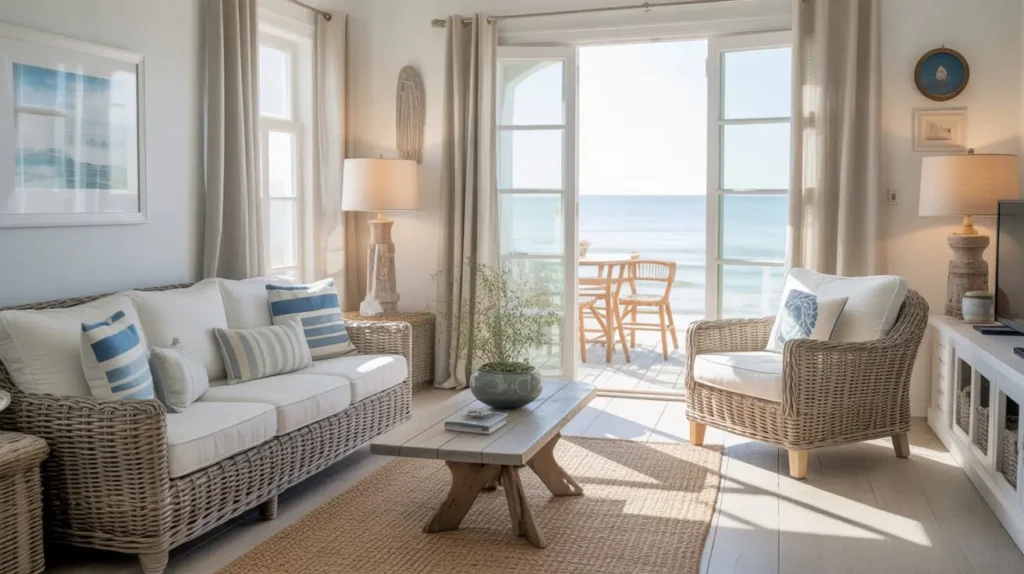
Coastal style brings beach vibes home, whether you live by the ocean or nowhere near water. This look creates a breezy, relaxed atmosphere that feels like perpetual vacation mode.
Your color palette pulls from the beach: soft blues, seafoam greens, sandy beiges, and crisp whites. The overall feeling should be light and airy, like ocean breezes are constantly flowing through your space.
Natural materials dominate: rattan furniture, jute rugs, driftwood accents, and linen textiles. The furniture tends to be comfortable and casual—no stuffy formal pieces here. Think slipcovered sofas in white or light blue, weathered wood coffee tables, and woven baskets for storage.
Decorative elements reference the ocean without going full nautical theme. A few shells or coral pieces? Beautiful. Anchor print everything and rope details on every surface? Maybe dial it back. The best coastal rooms feel subtly beach-inspired rather than overly themed.
Let in as much natural light as possible. Sheer white curtains or bamboo shades allow sunlight to filter through while maintaining privacy. Add some greenery—palms or tropical plants work perfectly—and maybe some coastal-inspired artwork.
The goal is creating a living room that feels relaxed and vacation-ready, where you can kick off your shoes and feel the stress melt away. It’s casual elegance at its finest.
Also Read: 15 Cozy Mid Century Modern Living Room Ideas You Must Try
Earthy Tones & Natural Textures
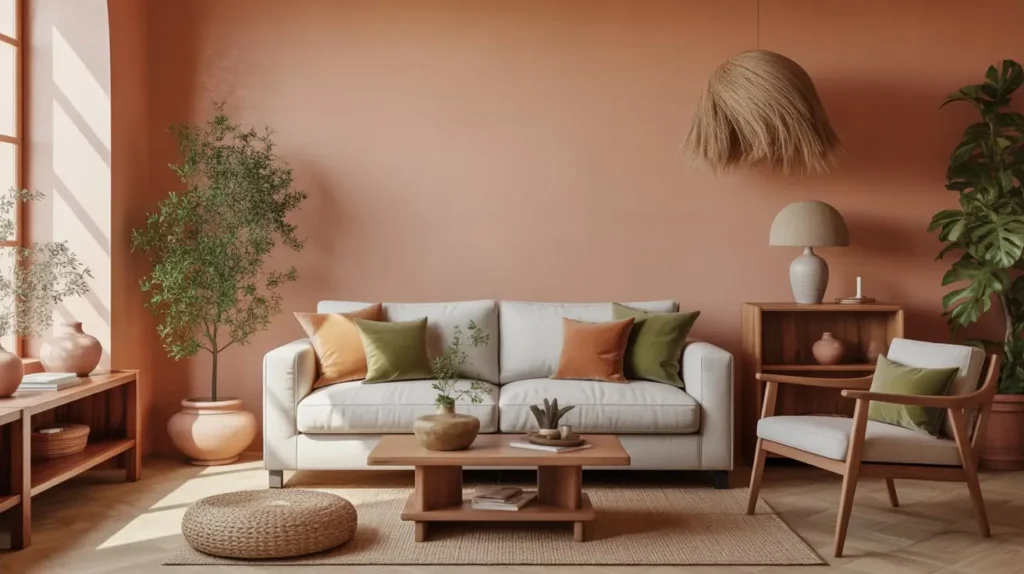
If you feel most at peace surrounded by nature, earthy design brings those grounding elements indoors. This aesthetic focuses on natural materials, organic shapes, and a color palette pulled straight from the outdoors.
Your colors come from the earth: warm terracotta, clay, ochre, deep forest greens, rich browns, and sandy neutrals. These tones create a cocoon-like warmth that makes you feel instantly comfortable.
Materials and textures are everything here. Incorporate raw wood, stone, clay, leather, wool, and linen. The more natural and unprocessed, the better. A live-edge wood coffee table, ceramic vases, woven wall hangings, and stone accessories all contribute to that organic vibe.
Furniture should feel solid and grounding—substantial wooden pieces, low-profile seating, and natural fiber rugs. Add plenty of plants (you saw that coming, right?) to literally bring nature inside. The bigger the plant, the better the impact.
What I love about earthy design is how it changes with the seasons. In fall and winter, layer in chunky knits and deeper colors. Spring and summer call for lighter linens and fresher greenery. Your living room evolves naturally throughout the year.
This style works particularly well if you’re trying to create a calming, restorative space. The natural materials and earthy colors have this inherent peaceful quality that helps you decompress and reconnect with yourself.
Moody Dark Aesthetic Living Room
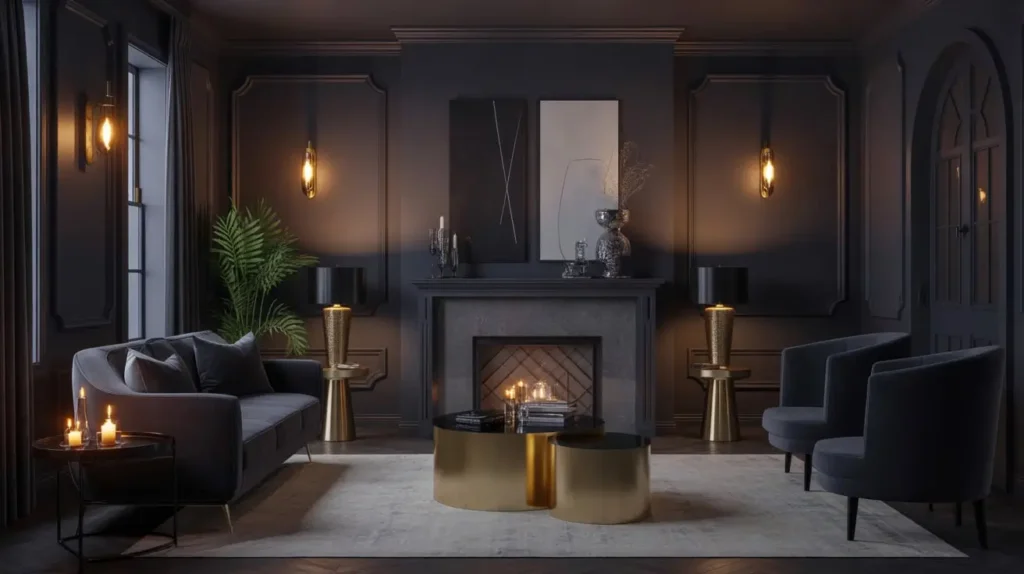
Who says living rooms need to be bright and airy? Dark, moody spaces have this dramatic, cozy vibe that’s honestly irresistible. If you’re brave enough to embrace darker colors, the payoff is huge.
Start with deep, saturated wall colors—charcoal grey, navy blue, forest green, or even black. Yes, black walls can work beautifully. These dark backgrounds create a cocoon effect that makes spaces feel intimate and sophisticated.
Your furniture can go lighter to create contrast, or stay dark for full drama. A charcoal velvet sofa against navy walls? Chef’s kiss. Rich leather furniture in a room with dark green walls? Absolutely stunning. The key is varying your tones so everything doesn’t blend into a dark blob.
Lighting becomes crucial in moody spaces. You need layered lighting—ambient, task, and accent—to prevent the room from feeling like a cave. Use table lamps, floor lamps, and maybe some LED strips to create warmth and dimension. Brass or gold fixtures add a luxe touch against dark backgrounds.
Texture and pattern keep dark rooms interesting. Mix matte and glossy finishes, rough and smooth textures, solid colors and subtle patterns. A Persian rug with deep colors, velvet pillows, and maybe some metallic accents all add visual interest.
Dark living rooms aren’t for everyone, but if you’ve ever wanted your space to feel like a sophisticated lounge or cozy library, this aesthetic delivers. Plus, movie nights in a dark room? Perfection.
Color-Pop Eclectic Design
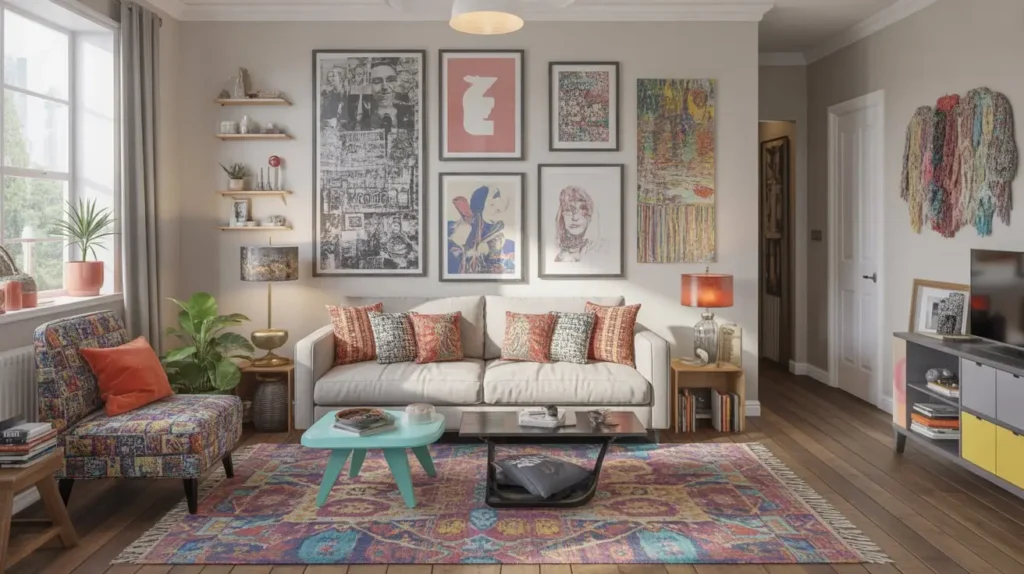
Some people like to play it safe with neutrals. Then there are those of us who think “why have one color when I can have twelve?” Eclectic, color-forward living rooms celebrate personality, creativity, and breaking all the traditional design rules.
This style gives you permission to mix patterns, clash colors (intentionally), and combine pieces from different eras and styles. That vintage armchair? It sits perfectly next to your modern geometric side table. The bohemian rug? It actually works under your mid-century sofa.
Your color palette is… everything. Jewel tones, pastels, brights, and neutrals all coexist. The trick is finding a common thread—maybe you’re using a lot of warm tones, or your patterns all share a similar scale, or you’re sticking to a specific color family.
Layer patterns like you’re getting paid for it. Striped pillows with floral throws and geometric rugs can absolutely work together if you’re thoughtful about color and scale. Start with a larger-scale pattern and layer in smaller ones to avoid visual chaos.
Furniture and accessories should feel collected over time rather than bought as a matching set. Vintage finds, handmade pieces, travel souvenirs, and family heirlooms all contribute to the eclectic vibe. Each piece should have a story or meaning.
The beauty of eclectic design is that it’s uniquely yours. No one else will have the same combination of pieces, colors, and patterns. Your living room becomes a reflection of your personality rather than a catalog recreation.
Elegant Black and White Space

Black and white color schemes are timeless, sophisticated, and surprisingly versatile. This classic combination creates high contrast and visual impact while staying neutral enough to work with changing accessories and trends.
You can go several directions with black and white. Classic and traditional uses damask patterns, tufted furniture, and elegant accessories. Modern black and white features clean lines, geometric patterns, and minimal ornamentation. Both work beautifully.
The ratio of black to white matters. A mostly white room with black accents feels bright and fresh. A mostly black room with white accents feels dramatic and bold. Equal amounts create high contrast that’s striking but can be intense, so choose based on your preference and natural light.
Introduce texture to prevent the space from feeling flat. A white boucle sofa, black leather chair, marble coffee table, and patterned rug in black and white all add dimension through varied materials and textures.
Here’s where you can play: accent colors. A black and white foundation lets you swap in different accent colors whenever you want. Throw pillows in emerald green this season, swap to coral next season. Your base stays classic while allowing flexibility.
Black and white rooms photograph incredibly well (hello, Instagram), but they also function beautifully in real life. They’re sophisticated without trying too hard, and they never really go out of style.
Small Space Smart Layout

Not everyone has a sprawling living room, and that’s totally okay. Small living spaces just require smarter planning and multifunctional solutions. You can absolutely create a cozy, stylish living room in a compact footprint.
First, choose furniture that fits the scale of your room. That massive sectional might look amazing, but if it swallows your entire space, it’s not the right choice. Opt for a smaller sofa or loveseat, armless chairs, or even floor cushions that you can move easily.
Multifunctional pieces are your best friend. Ottomans with storage, coffee tables that lift to become work surfaces, sofas that convert to guest beds—these pieces work harder so your space functions better. Every item should earn its place by serving multiple purposes.
Vertical space is criminally underused in small rooms. Mount shelves higher on walls, use tall bookcases, hang artwork closer to the ceiling. Drawing the eye upward makes rooms feel larger while providing practical storage.
Keep your color palette light and cohesive. Lighter colors reflect light and make spaces feel more open. That doesn’t mean boring—you can absolutely add pops of color through accessories, artwork, or one accent wall.
Mirrors are basically magic for small spaces. They reflect light and create the illusion of more space. A large mirror on one wall can visually double your room size. Strategic lighting—multiple light sources rather than one overhead fixture—also helps small rooms feel more spacious.
Vintage-Inspired Living Room Revival
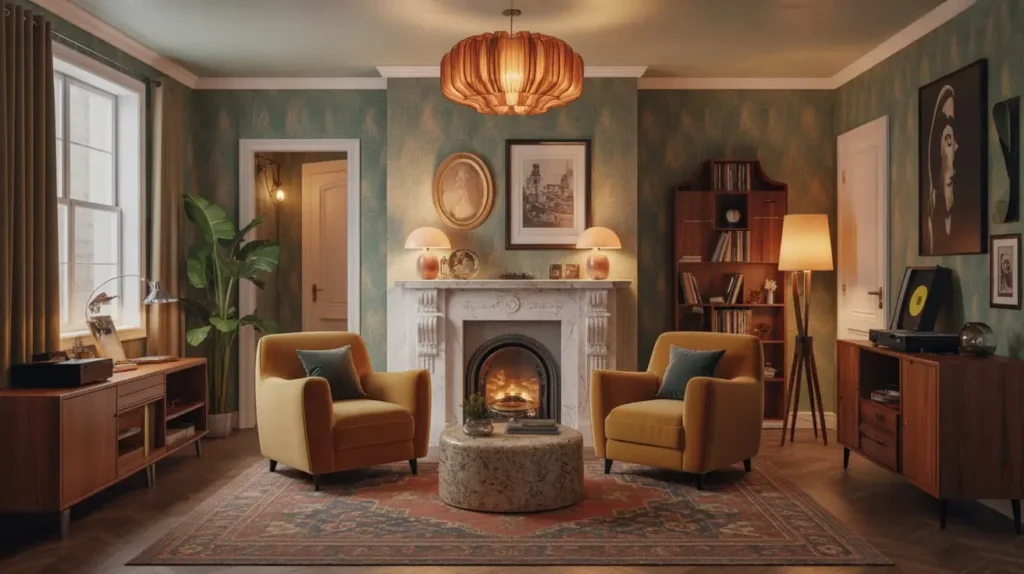
Everything old is new again, right? Vintage-inspired living rooms celebrate character, craftsmanship, and the charm of bygone eras. You’re creating a space that feels curated, collected, and full of stories.
Choose your era or mix several. Maybe you’re obsessed with 1920s Art Deco elegance, 1950s mid-century charm, or 1970s bohemian vibes. Each era has distinctive furniture styles, colors, and decorative elements that you can reference or fully embrace.
Hunt for authentic vintage pieces at estate sales, antique shops, and online marketplaces. An actual vintage credenza has character that reproductions can’t match. That worn patina and craftsmanship quality? Those are features, not flaws.
Mix vintage finds with modern comforts. Your grandmother’s beautiful armchair might need reupholstering in updated fabric. That vintage sideboard can hold your very modern TV and gaming consoles. The combination of old and new keeps spaces feeling fresh rather than stuck in the past.
Color palettes depend on your chosen era. Art Deco uses blacks, golds, and jewel tones. Mid-century loves teal, orange, and avocado green. Victorian leans toward rich burgundies and deep greens. Choose what speaks to you.
The beauty of vintage style is the treasure hunt. Finding that perfect piece takes time, but when you discover it, the satisfaction is real. Your living room becomes a curated collection rather than an overnight makeover, and honestly? That’s way more interesting.
Look, creating your dream living room doesn’t happen overnight (despite what those home makeover shows suggest). It’s about figuring out what makes you feel comfortable, what reflects your personality, and what actually works for how you live.
Maybe you’re drawn to the clean simplicity of Scandinavian design, or perhaps you want to embrace maximalist eclectic chaos. You might crave the sophisticated drama of dark moody spaces, or find peace in earthy natural materials. None of these choices are wrong—they’re just different paths to creating a space you’ll actually want to spend time in.
The best living room is the one where you feel at home. Whether that means surrounding yourself with vintage treasures, embracing coastal calm, or going full glamorous with gold accents, trust your instincts. Your space should work for your life, your style, and your budget.
So grab some inspiration from these ideas, mix and match what speaks to you, and create a living room that makes you smile every time you walk through the door. That’s the real goal here—not perfection, just a space that feels perfectly you.




